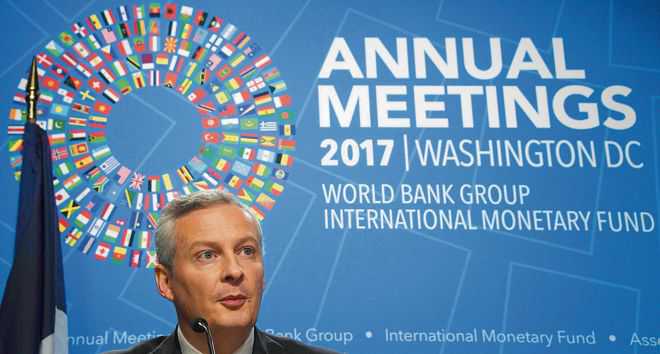
Grim view: World Bank and IMF project a downward growth for India for 2019-20.
Jayshree Sengupta
Senior fellow, observer research foundation
Recently, the World Bank and the International Monetary Fund (IMF) revised their growth projections for India downwards for 2019-20. While the World Bank’s forecast for India’s GDP growth is 7.5, IMF’s forecast is a notch lower at 7.3 per cent.
The IMF, in its World Economic Outlook released recently, has also raised the fear of a slowdown in global output growth. Instead of growing at 3.5 per cent as previously forecast, world output will grow at 3.3 per cent this year. Also, following the big trade dispute between the US and China, the WTO’s forecast for world trade growth is lower at 3.7 per cent in 2019 instead of 3.9 per cent in 2018.
There are many factors that are responsible for a slower projected growth for India. Some are external like the global trade slowdown that will have repercussions not only on the GDP growth of China but on China’s trade partners like India.
Regarding India’s growth rate, the Chief Economist for the South Asian Region, Hans Timmer of the World Bank, has pointed out that it has been ‘too much’ driven by domestic demand and, hence, the next government should focus on export-led growth. According to him, strong domestic demand has resulted in the double-digit growth of imports which has led to the widening of the current account deficit. The next government's focus should be on reducing the stimulus for domestic demand. It should undertake trade liberalisation on the import side which would create more competition and export-led growth would lead to increase in productivity. India has been only exporting 10 per cent of its GDP whereas even 30 per cent would be normal.
Today, however, India is facing a slowdown in industrial and manufacturing growth because of shrinking consumer demand. Various industries from automobiles, scooters and consumer durable goods are facing a decline in demand on the back of continued agricultural distress and slow rise in rural consumption power which is due to lack of adequate investment in the agricultural sector. Many of the current problems in agriculture relate to poor infrastructure, especially storage and marketing facilities in villages. Improvement in roads, transportation and marketing infrastructure will help farmers realise better prices for their produce and improve their incomes and demand.
The manufacturing sector also needs huge investments for its modernisation and innovations. Thus, the main task before the new government will be to revive demand through higher rates of investment in the industrial and agricultural sectors. Industrial growth sunk to 20-month low of 0.1 per cent in March 2019. The slowdown in investment is evident in the slow growth of the capital goods industries which contracted by 8.8 per cent in February, 2019. All these are symptoms of a deep malaise showing economic slowdown acknowledged by the RBI recently, which will be visible in the GDP figures in the future. India still maintains the tag of one of the fastest growing economies in the world mainly due to the high rate of service sector growth, but with world output slowing down, it may be difficult to sustain the momentum.
The World Bank is right and India does need to revive export growth as it has been flat and below target in the last two years. Exports grew at 2.44 per cent in February but have suddenly picked up in March to 9 per cent. This could be a blip or the new trend if India regains its competitiveness in labour-intensive goods like garments and light manufactures vis-a-vis countries like Vietnam and Bangladesh.
Reviving export growth will boost industrial growth. But the old export-led growth model of the 1970s is no longer feasible in a world ridden with widespread protectionism. When the East Asian Tigers experienced rapid export-led growth, the world trade environment was different and China was not such a giant manufacturing hub of the world. Today many countries, including India, have turned protectionist against the import surge mainly from China.
India will have to encourage investment-driven infrastructural growth that will involve upgrading roads, ports, airports, canals, power and railways which would help resuscitate MSMEs that contribute 40 per cent to exports. Also, India has to fight against non-tariff barriers if exports are to take off. Exporters have been vulnerable to growing number of non-tariff barriers in EU and the US. Huge consignments are often rejected on grounds of hygiene. India has to focus on better quality education and skill development also to step up export growth.
India needs to protect itself from unfair dumping of cheap manufactures and agricultural goods from abroad. Protection through higher tariffs has been undertaken by the NDA government. But the measures can just offer temporary relief to industries like electronics. In the long run, the Indian industry has to become more competitive and higher tariffs will make inputs expensive, affecting industrial and export growth adversely.
Financing of exports is a stumbling block and the MSME sector has been facing liquidity crunch after the IF&LS collapse which led to the drying up of NBFC source of finance. MSMEs also borrow from public sector banks which have become reluctant to lend as they are saddled with Rs 8,64,433 crore in NPAs. The government has stepped in to ease the MSME liquidity crisis, but unless the PSBs are adequately recapitalised, the problem of advancing sufficient credit to exporters will be an impediment towards higher export growth.



























